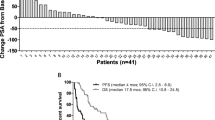Abstract
Introduction: Suramin is a synthetic polysulfonated naphthylurea which has been used for the treatment of African trypanosomiasis and onchocerciasis, but since the mid-1980s has received attention as a possible antiretroviral and antineoplastic agent. Objective: This clinical trial of suramin was undertaken as a phase I/II study in patients with hormone-refractory prostate cancer, with the hypothesis that the intensity of therapy with suramin could be increased significantly if measures were undertaken to maintain the plasma concentrations of the drug under 300 μg/ml. Methods: We report the clinical results of this trial, wherein patients were treated at three different targeted plasma suramin concentrations (275, 215 and 175 μg/ml) for varying periods of time (2, 4 or 8 weeks), with delivery of the drug by continuous intravenous infusion. Results: The major toxicity observed in this trial was neurologic, consisting of a motor and sensory peripheral neuropathy that resulted in both paresis and paralysis of the limbs. Nearly all of this severe (CTEP grade III, IV) neurologic toxicity was observed in the patients treated at a plasma suramin concentration of 275 μg/ml for 4 or more weeks. A single patient treated at 215 μg/ml for 8 weeks developed moderate (CTEP grade III) proximal lower extremity weakness, and no patient treated at 175 μg/ml developed this toxicity. The second most common toxicity observed was infection of the central venous catheter. The overall response rate for all of the evaluable patients was 17% (13 of 75 patients). In addition, prostate-specific antigen (PSA)-defined responses were observed in six patients receiving therapy at 175 μg/ml, but these responses were confounded by cessation of therapy with flutamide during suramin treatment. Conclusions: In summary, although plasma suramin concentrations were maintained below 300 μg/ml, neurologic toxicity nonetheless occurred with high frequency in patients treated at 275 μg/ml for 4 or more weeks. Therapy at 215 and 175 μg/ml was in general well tolerated, but central venous catheter-related infection, as well as the inconvenience and expense of continuous infusional therapy, make this method of drug delivery impractical. Only moderate antitumor activity was observed during this trial, but it is possible that both continuation of flutamide and flutamide withdrawal during suramin therapy confounded the assessment of suramin’s activity in hormone-refractory prostate cancer.
Similar content being viewed by others
Author information
Authors and Affiliations
Additional information
Received: 9 June 1995/Accepted: 18 March 1996
Rights and permissions
About this article
Cite this article
Bowden, C., Figg, W., Dawson, N. et al. A phase I/II study of continuous infusion suramin in patients with hormone-refractory prostate cancer : toxicity and response. Cancer Chemother Pharmacol 39, 1–8 (1996). https://doi.org/10.1007/s002800050531
Issue Date:
DOI: https://doi.org/10.1007/s002800050531




